*We are a reader-supported website. When you buy through links on our site, we may earn a small affiliate commission at no extra cost to you. Home Media Entertainment does not accept money for reviews.*
Introduction
Audio plays a pivotal role in the immersive experience of a home theater. The heart-pounding bass of an action scene, the subtle whispers of a thriller, or the harmonious melodies of your favorite music all come to life through sound. As technology advances, so does the quality of sound in our home theaters, making it an essential aspect of our cinematic and musical enjoyment.
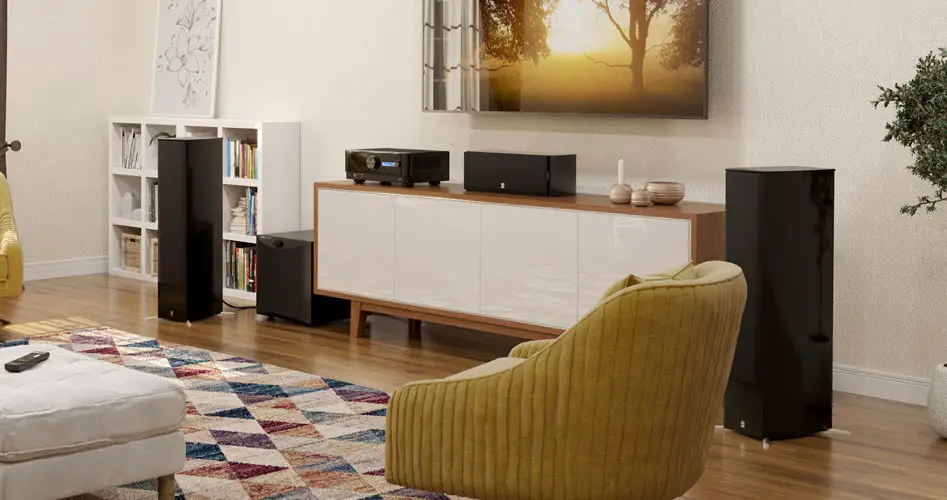
In this article, we will explore the science of surround sound in home theaters. Additionally we’ll delve into the intricacies of sound waves, the history of surround sound, the components of a home theater sound system, and the principles that make surround sound technology work. By the end of this journey, you’ll have a deeper understanding of how to create an immersive audio experience in your own home theater setup.
But let’s begin by unraveling the basics of sound. From the vibrations in the air to how our ears perceive these waves.
Understanding the Basics of Sound
Sound is a remarkable phenomenon that adds depth and richness to our home theater experiences. Before we dive into the intricacies of surround sound, it’s crucial to comprehend the fundamentals of sound waves and how our ears interpret them.
Sound Waves: The Building Blocks of Audio
Sound is created when an object vibrates, producing waves of pressure variations in the air. These waves consist of two key properties:
- Frequency and Wavelength: Frequency refers to how fast a sound wave vibrates, measured in Hertz (Hz). High frequencies create treble sounds, like a bird’s chirp, while low frequencies produce bass sounds, like a deep drumbeat. Wavelength is the physical distance between successive points of a wave.
- Amplitude and Loudness: Amplitude represents the height of the wave, determining the volume or loudness of a sound. Larger amplitudes create louder sounds, while smaller ones result in quieter tones.
How Our Ears Perceive Sound
Our ears are incredibly sophisticated organs that detect and process sound waves. Here’s a simplified overview of how this happens:
- Firstly sound waves travel through the air and enter the ear canal.
- As a result they strike the eardrum, causing it to vibrate.
- These vibrations are then transmitted to tiny bones in the middle ear.
- The movement of these bones amplifies the vibrations and transmits them to the inner ear.
- Then, in the inner ear, hair cells convert the vibrations into electrical signals.
- These signals are sent to the brain, where they are interpreted as specific sounds, such as voices, music, or the rustling of leaves.
Understanding these foundational concepts of sound is essential as we explore the world of surround sound and its impact on our home theater experiences. But first, let’s journey through the history and development of surround sound.

The Birth of Surround Sound
To truly appreciate the marvels of surround sound in today’s home theaters, we must take a step back in time and explore its fascinating history and development. The journey from mono to stereo and the pivotal role played by Walt Disney’s Fantasia and the advent of Dolby Surround have significantly shaped the audio landscape.
From Mono to Stereo: The Evolution Begins
In the early days of audio reproduction, monaural (mono) sound was the standard. But mono systems used a single channel to deliver sound, resulting in a flat and one-dimensional auditory experience. While it served its purpose, the desire for a more immersive and realistic audio experience led to the development of stereo.
On the other hand stereo sound, introduced in the mid-20th century, employed two channels—left and right—to create a sense of spatial depth. As a result, this breakthrough allowed for the separation of sound sources, making it possible to hear different instruments or voices coming from different directions. Stereo laid the foundation for the surround sound systems we enjoy today.
Walt Disney’s Fantasia: A Milestone in Audio
Walt Disney’s 1940 animated masterpiece, “Fantasia,” played a pivotal role in advancing the possibilities of sound in cinema. The film showcased a revolutionary multi-channel audio system known as “Fantasound,” which used multiple speakers placed around the theater to envelop the audience in a symphonic experience. This innovative approach set the stage for future developments in surround sound technology.
The Advent of Dolby Surround: A Game-Changer
Equally important, the 1970s saw the introduction of Dolby Surround, a groundbreaking technology that marked a significant leap in home audio. Because Dolby Surround utilized four channels: front left, front center, front right, and a single rear channel. This configuration allowed for a more immersive experience, as sounds could now move from the front to the rear, enveloping the listener in a 360-degree auditory landscape.
As we continue our journey through the world of surround sound, it’s clear that these historical milestones paved the way for the advanced audio systems we enjoy in our home theaters today.
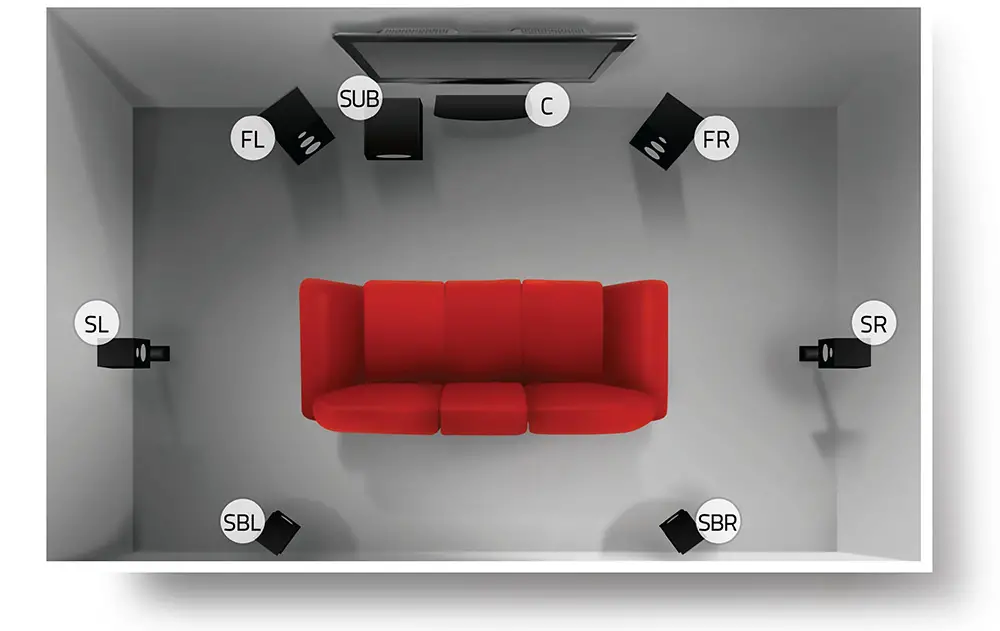
The Anatomy of a Home Theater Sound System
Understanding the components of a home theater sound system is essential when aiming for an immersive audio experience. In this section, we’ll break down the key elements that make up a typical home theater audio setup.
Main Speakers: Front, Center, and Rear
A home theater audio system typically consists of a combination of speakers carefully positioned to deliver a multidimensional soundscape. These speakers include:
- Front Speakers: These speakers are responsible for reproducing the main audio elements, including dialogue, music, and most sound effects. For that reason they are usually placed on either side of the screen, providing a wide soundstage.
- Center Speaker: The center speaker plays a critical role in anchoring dialogue to the on-screen action. It ensures that voices come from the direction of the characters, enhancing the overall viewing experience.
- Rear Speakers: Positioned behind the seating area, rear speakers create the sense of envelopment and immersion. They are responsible for ambient sounds, background music, and directional audio effects.
Subwoofers: Adding Depth to the Bass
Subwoofers are specialized speakers designed to reproduce low-frequency sounds, commonly referred to as bass. They add depth and impact to explosions, deep rumbling, and the low tones of music. Therefore subwoofers should be strategically placed to achieve optimal bass distribution.
Audio Receivers: The Brain of the System
An audio receiver serves as the control center for your home theater sound system. It processes audio signals, amplifies them, and distributes them to the appropriate speakers. Obviously modern receivers come equipped with various features, including support for multiple audio formats, connectivity options, and room calibration technology.
Surround Sound Formats: Dolby Atmos, DTS:X, and More
Home theater audio has evolved beyond traditional surround sound, thanks to formats like Dolby Atmos and DTS:X. In brief, these formats introduce height channels and object-based audio, enabling sound to come from above and move dynamically around the listener. Keep in mind that compatibility with these formats depends on the equipment and content you choose.
Without a doubt, understanding the anatomy of a home theater sound system lays the foundation for creating an immersive audio experience. For this reason in the next section, we’ll explore how surround sound technology actually works, including the role of sound channels, speaker positioning, and room acoustics.
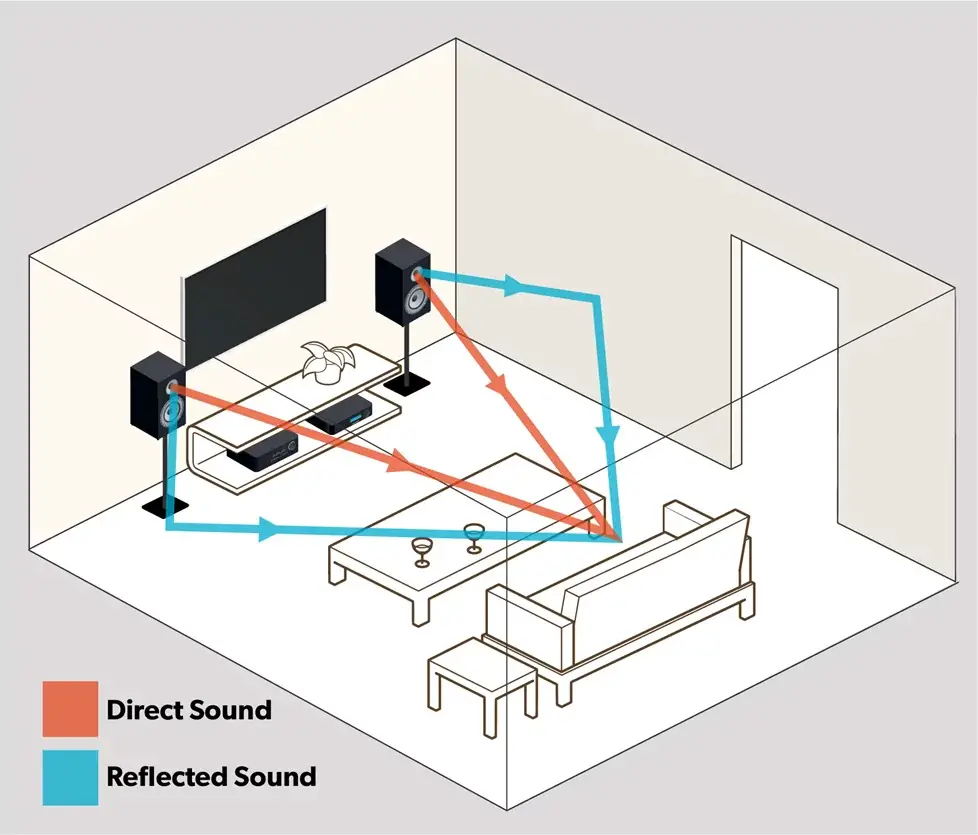
How Surround Sound Works
Now that we’ve explored the components of a home theater sound system, let’s delve into the principles that make surround sound technology function seamlessly. Because understanding how sound channels, speaker positioning, and room acoustics work together is vital for creating an immersive audio environment in your home theater.
Sound Channels and Audio Tracks
Surround sound relies on the concept of sound channels, each dedicated to specific audio elements. These channels include:
- Front Channels: Responsible for dialogue, music, and primary sound effects, these channels are typically delivered through the front and center speakers.
- Rear Channels: Positioned behind the audience, these channels handle ambient sounds, background music, and audio effects that create a sense of envelopment.
- Subwoofer Channel: Focused on low-frequency sounds, the subwoofer channel adds depth and impact to bass-heavy elements like explosions and deep rumbles.
- Height Channels (Dolby Atmos, DTS:X): In advanced systems like Dolby Atmos and DTS:X, height channels introduce a new dimension by delivering sound from above. This creates a 3D audio experience, allowing sound to move freely in any direction.
Sound Reflections and Room Acoustics
Sound waves can bounce off surfaces, leading to reflections that impact audio quality. Therefore to optimize your surround sound setup:
- Use acoustic treatments like diffusers and absorbers so you can minimize reflections and create a more controlled sound environment.
- Experiment with speaker placement and angles in order to find the best configuration for your room’s acoustics.
Understanding these key principles of surround sound technology is essential for creating an immersive audio experience in your home theater. In the next section, we’ll take a closer look at the immersive capabilities of Dolby Atmos technology.
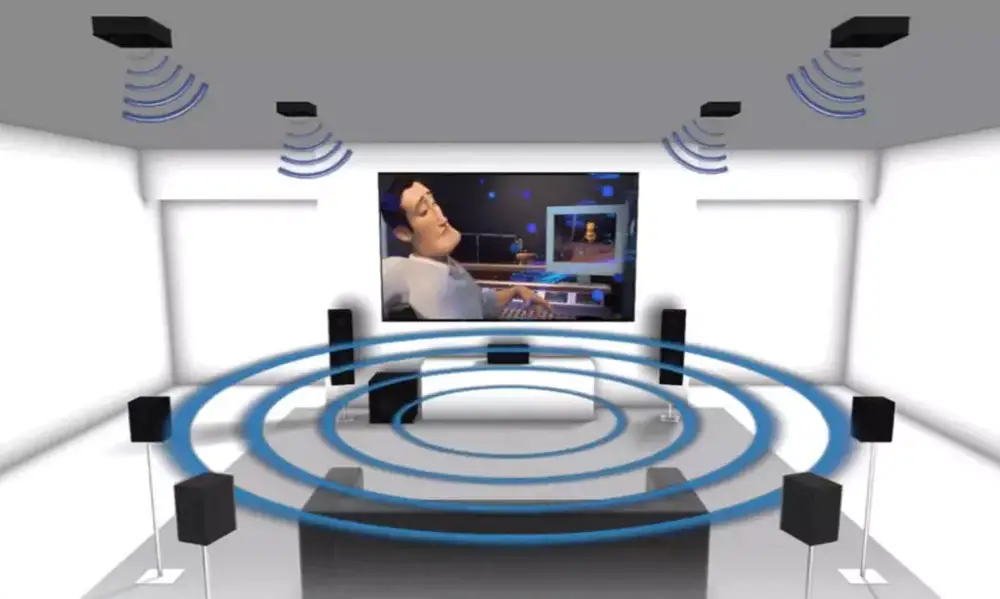
The Immersive Experience of Dolby Atmos
As technology continues to advance, Dolby Atmos has emerged as a groundbreaking audio technology. Because it takes the surround sound experience to new heights—literally. In this section, we’ll dive deeper into Dolby Atmos, exploring its object-based audio, height channels, and compatibility with content and streaming platforms.
Object-Based Audio: A Revolution in Sound
Dolby Atmos introduces the concept of object-based audio, which is a significant departure from traditional channel-based audio systems. Instead of assigning sounds to specific channels, object-based audio treats sound as independent objects in a 3D space. Unquestionably, this innovation allows audio engineers to precisely position sounds anywhere in the room.
Height Channels and Overhead Sound
One of the defining features of Dolby Atmos is its use of height channels. Because these channels introduce sound from above, creating a three-dimensional audio experience. By placing speakers on the ceiling or utilizing upward-firing technology, Dolby Atmos can make you feel like you’re in the middle of the action, with sounds coming from all around and even from overhead.
Compatible Content and Streaming Platforms
Obviously to enjoy the full benefits of Dolby Atmos, you’ll need compatible content and streaming platforms. In addition, many modern movies and TV shows are now produced with Dolby Atmos audio tracks, enhancing the home viewing experience. Popular streaming services like Netflix, Disney+, and Amazon Prime Video offer Dolby Atmos support, so you can immerse yourself in cinematic sound from the comfort of your home.
In brief, Dolby Atmos technology represents a significant leap forward in home theater audio, delivering unparalleled immersion and realism.

Choosing the Right Speakers and Equipment
Selecting the appropriate speakers and equipment for your home theater is pivotal in achieving the best audio experience. In this section, we’ll guide you through the factors to consider when choosing speakers, ensuring receiver compatibility, and weighing budget-friendly options versus high-end setups.
Factors to Consider When Buying Speakers
When shopping for speakers, it’s essential to keep the following factors in mind:
- Speaker Type: Consider the speaker types you need for your setup, including front, center, rear, and subwoofers. Additionally ensure they are compatible with your room size and layout.
- Speaker Sensitivity: Higher sensitivity speakers require less power to produce the same volume, hence making them suitable for lower-powered amplifiers.
- Impedance: Match the impedance (measured in ohms) of your speakers to the impedance rating of your audio receiver for optimal performance.
- Frequency Range: Look for speakers with a wide frequency range to reproduce both high and low frequencies accurately.
- Speaker Placement: Plan the placement of your speakers according to your room’s acoustics and the layout of your home theater.
Receiver Compatibility
Your audio receiver plays a critical role in your home theater setup. Ensure it is compatible with the speakers and audio formats you plan to use. Check for features like Dolby Atmos or DTS:X support, the number of channels it can handle, and connectivity options such as HDMI, Bluetooth, and Wi-Fi.
Budget-Friendly Options vs. High-End Setups
Choosing between budget-friendly and high-end setups depends on your preferences and budget. Consider the following:
- Budget-Friendly: These setups offer good sound quality at an affordable price. Therefore they are suitable for casual viewers and listeners who want a solid audio experience without breaking the bank.
- High-End: High-end setups are designed for audiophiles and cinephiles who demand the best audio quality. They often feature premium speakers, amplifiers, and room calibration technology for an unparalleled experience.
Consequently, the right speakers and equipment should align with your goals, budget, and space.
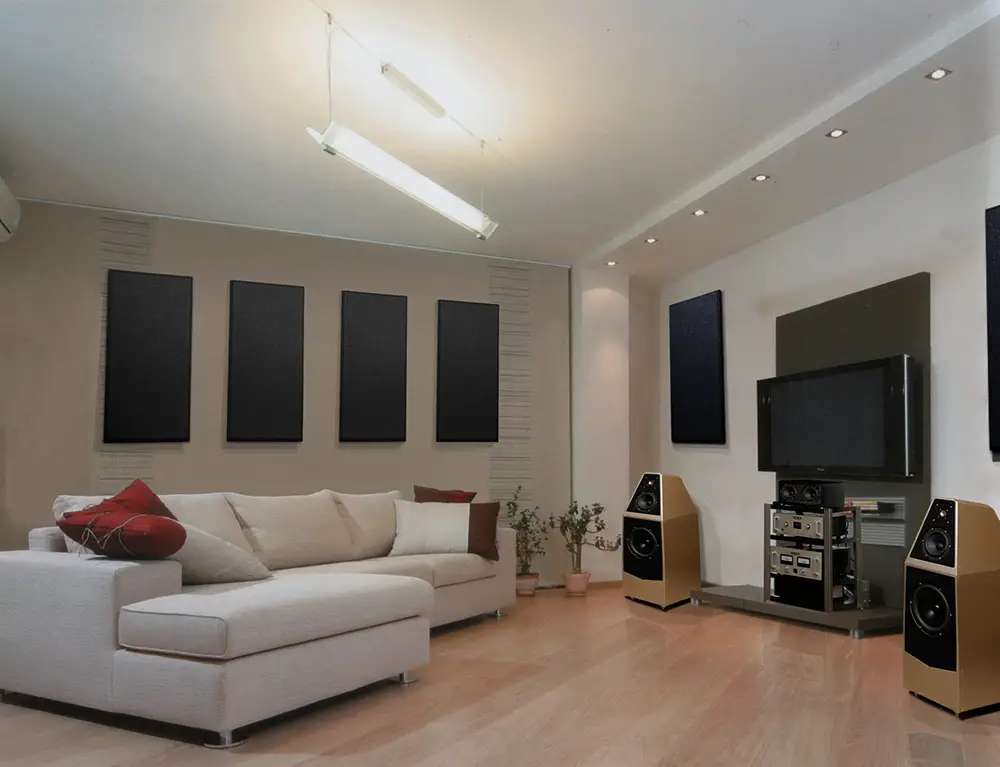
Setting Up Your Home Theater for Optimal Sound
Achieving optimal sound quality in your home theater requires careful planning and setup. Therefore in this section, we’ll offer practical tips on how to maximize the audio experience in your home theater environment. This includes speaker placement for optimal audio imaging, the use of acoustic treatments and soundproofing, as well as calibration tools and software.
Speaker Placement for Optimal Audio Imaging
Proper speaker placement is critical to ensuring accurate audio imaging and a well-balanced soundstage. Here are some key tips:
- Front Speakers: Position front speakers at ear level when seated, and ensure they are equidistant from the primary listening position.
- Center Speaker: Align the center speaker with the screen’s horizontal center and at ear level, ensuring clear and focused dialogue.
- Rear Speakers: Place rear speakers slightly above ear level and angle them towards the seating area to create a sense of envelopment.
- Subwoofers: Experiment with subwoofer placement to find the optimal location for deep and impactful bass without overwhelming the room.
Acoustic Treatments and Soundproofing
Enhancing the acoustics of your home theater room can significantly improve sound quality:
- Acoustic Panels: Install acoustic panels on walls and ceilings to reduce sound reflections and echoes, creating a more controlled audio environment.
- Bass Traps: Use bass traps in corners to address low-frequency resonances and improve bass clarity.
- Soundproofing: Consider soundproofing measures like adding mass-loaded vinyl or acoustic curtains to minimize sound leakage into or from adjacent rooms.
Calibration Tools and Software
Most modern audio receivers come with calibration tools and software that can help optimize your home theater’s audio. For example, these tools analyze the room’s acoustics and adjust speaker settings to deliver the best possible sound quality. Follow the instructions in your receiver’s manual to run the calibration process.
By carefully setting up your home theater for optimal sound, you can ensure that every seat in the room provides a captivating and immersive audio experience.
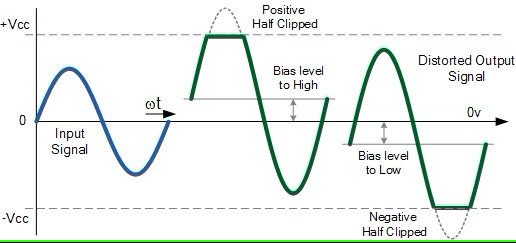
Troubleshooting Common Sound Issues
Even with careful setup, home theater enthusiasts may encounter common sound problems that can detract from the immersive experience. In this section, we’ll address some of these issues and provide troubleshooting solutions to help you enjoy flawless audio in your home theater.
Sound Distortion and Clipping
Problem: Sound distortion or clipping occurs when the audio signal is too loud for the speakers or the amplifier to handle. This results in a distorted, unpleasant sound.
Solution:
- Adjust Volume: Lower the volume on your audio receiver to a level where distortion disappears. Avoid pushing the system to its limits.
- Check Speaker Specifications: Ensure that your speakers and amplifier are matched in terms of power handling. If your speakers are rated for a specific wattage, make sure your amplifier doesn’t exceed that rating.
Dialogue Clarity Issues
Problem: Dialogue in movies or TV shows may sometimes be difficult to understand, leading to frustration.
Solution:
- Center Speaker Adjustment: If dialogue clarity is an issue, consider adjusting the center speaker’s volume to make voices more distinct.
- Subtitle Option: Enable subtitles or closed captions for enhanced understanding, especially during scenes with heavy accents or mumbled dialogue.
Synchronization Problems
Problem: In some cases, audio and video may not sync correctly, resulting in a noticeable delay between what you see and hear.
Solution:
- Audio Delay Settings: Most modern audio receivers offer options to adjust audio delay. Experiment with these settings to synchronize audio with video.
- Check Source Device: Sometimes, the issue may originate from the source device, such as a Blu-ray player or streaming device. Ensure the source device’s settings are correctly configured.
By addressing these common sound issues, you can enjoy a smoother and more enjoyable home theater experience.

Future Trends in Home Theater Sound
The world of home theater sound is continually evolving, with new technologies and trends shaping the way we experience audio. In this section, we’ll discuss emerging technologies and trends in home theater audio, including next-gen audio codecs, voice recognition, AI-enhanced sound, and the potential impact of virtual reality.
Next-Gen Audio Codecs
Next-generation audio codecs are pushing the boundaries of home theater sound. These codecs promise higher-quality audio, more immersive experiences, and greater compatibility with various devices. Keep an eye out for advancements in codecs like:
- Object-Based Audio: Building on technologies like Dolby Atmos and DTS:X, object-based audio continues to evolve, offering even more precise sound positioning and immersion.
- High-Resolution Audio: As high-resolution audio becomes more accessible, expect to enjoy music and movies with greater detail and fidelity.
- New Audio Technologies: Recently new audio technologies have immerged. Sony’s 360 Spatial Sound Mapping and 360 Reality audio, MPEG-H and IMAX Enhanced sound are some of them. These have been created to provide an even more immersive experience thanks to their advanced characteristics.
Voice Recognition and AI-Enhanced Sound
Voice recognition technology is making its way into home theaters, allowing you to control your audio experience using voice commands. Additionally, AI-enhanced sound processing can adapt audio in real-time to match your preferences and the content you’re watching or listening to.
The Impact of Virtual Reality on Home Theater
Virtual reality (VR) is on the horizon for home theaters, promising to redefine the way we experience entertainment. VR headsets with integrated spatial audio capabilities will transport you to virtual worlds where sound is an integral part of the immersive experience.
Staying informed about these emerging technologies and trends will be crucial for keeping your home theater audio setup up-to-date.

Conclusion
In the world of home theaters, sound is more than just an accompaniment; it’s the key to transforming your living room into a cinematic and auditory wonderland. As we’ve explored in this article, the science of surround sound is a fascinating journey through the fundamentals of sound waves, the historical evolution of audio technology, and the intricacies of modern home theater audio systems.
From the birth of surround sound, exemplified by the groundbreaking “Fantasia” and the advent of Dolby Surround, to the immersive experiences offered by technologies like Dolby Atmos, we’ve seen how far audio has come. We’ve also delved into the critical aspects of choosing the right speakers and equipment, setting up your home theater for optimal sound, and troubleshooting common sound issues.
As you embark on your journey to create the perfect home theater audio setup, remember to stay attuned to the ever-evolving landscape of audio technology. Because next-generation audio codecs, voice recognition, AI-enhanced sound, and the promise of virtual reality are poised to reshape the way you experience sound in your home theater.
Therefore, we encourage you to explore these advancements, experiment with your setup, and immerse yourself in the world of surround sound. Whether you’re a cinephile, a music enthusiast, or simply someone who appreciates high-quality audio, your home theater can be a sanctuary of sonic delight. Thank you for joining us on this exploration of the science of surround sound in home theaters. We hope this article has provided you with valuable insights and inspiration to elevate your audio experience.
For more educational articles you can check our dedicated Educational Articles section.
Wow, what an in-depth exploration of the world of home theater audio! The section on speaker placement and room acoustics really caught my attention. So, I’m curious: what are some practical tips for DIY enthusiasts to improve room acoustics without breaking the bank? Thanks for the great read and all the information you provide!
Cheers!
Hello Claude. Thank you for your comment. We are preparing some articles that delve more into specific areas of a home theater design so I will ask you to keep checking back to see what we have in store for you soon.
Hello Stratos,
What an informative article! I’ve always been fascinated by the science behind surround sound, and this piece really breaks it down nicely. But I’m curious about one thing: With the rise of advanced audio technologies like Dolby Atmos, are there any significant changes needed in terms of room acoustics or speaker placement to fully embrace these new capabilities in a home theater setup? Thanks for sharing this knowledge.
Mark
For Dolby Atmos, room acoustics definitely become even more critical. Ideal placement of height speakers or upward-firing modules is key for getting the best out of this format. Especially with an up-firing setup, because the system relies on the bouncing effect, there are certain conditions to be met for overhead sound to reach your ears as it should. Also the shape of the ceiling is very critical. But overall a Dolby Atmos system needs more careful planning because it has more speakers to work with.